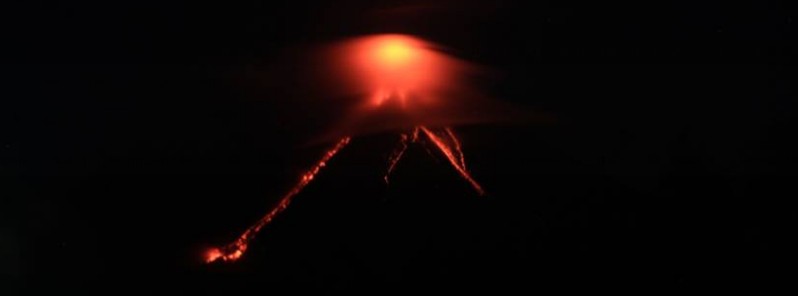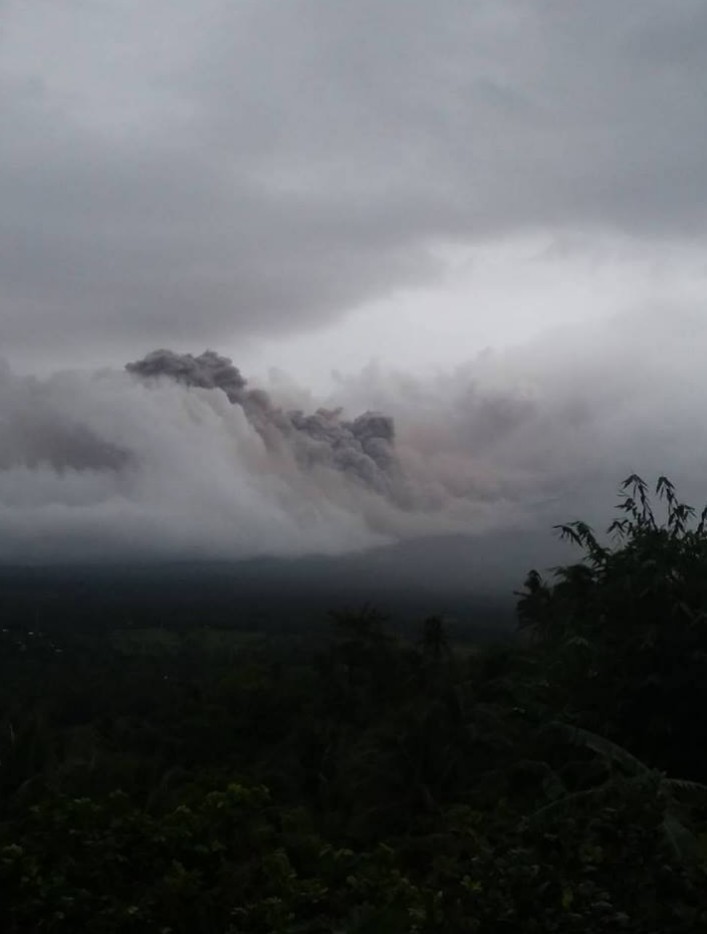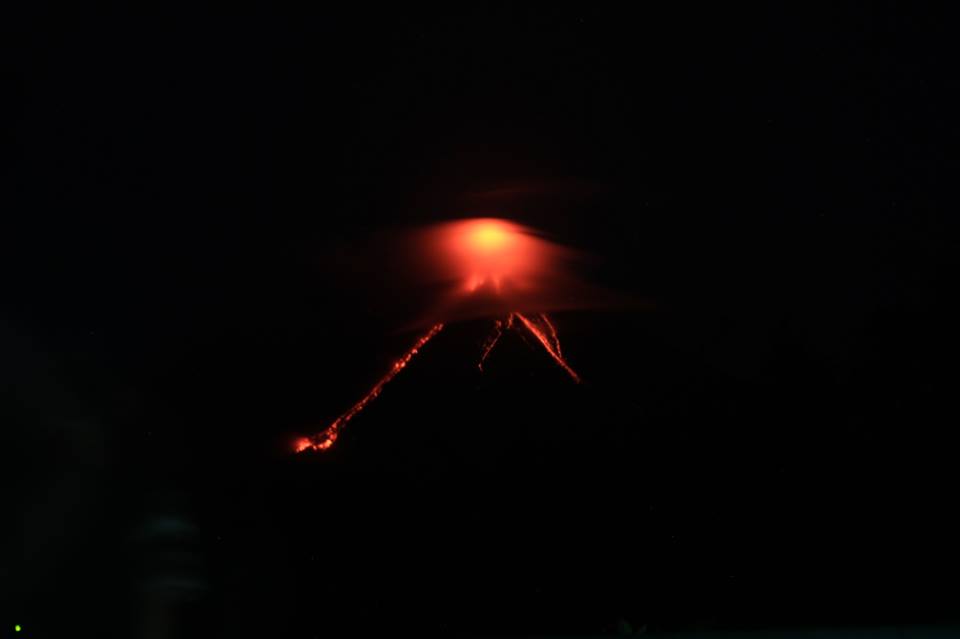Nearly 15 000 evacuated away from Mayon volcano, lava flows toward Miisi and Bonga

Authorities have evacuated nearly 15 000 people living in the vicinity of Mayon volcano, Albay Province, Philippines following its first eruption since 2014 on Saturday, January 13, 2018. Lava is flowing from the summit towards Miisi and Bonga gullies.
Mayon is ejecting ash and producing lahars since Saturday, January 13, forcing authorities to raise the Alert Level from 1 to 3. The volcano, however, was on Alert Level 1 since September 8, 2016.
Two lava collapse events occurred early Monday, January 15, triggering rockfall and small-volume pyroclastic flows, observed descending down the volcano at 01:47 UTC (09:47 local time):

Pyroclastic flow – Mayon volcano, Philippines on January 15, 2018. Credit: Mayon Volcano Observatory
The image below shows lava flows toward Miisi and Bonga gullies at 11:47 UTC, January 15:

Lava flows toward Miisi and Bonga gullies at 11:47 UTC (19:47 local time), January 15, 2018. Credit: Mayon Volcano Observatory
Renato Solidum, head of PHIVOLCS said lava flowed about 800 m (0.5 miles) from the crater on Monday morning and ash clouds appeared mid-slope as lava fragments rolled downs. "It was hard to track down the lava flow given the thick clouds shrouding the volcano," Solidum added.
Early Monday morning, Philippine National Disaster Risk Reduction and Management Council (NDRRMC) said they have already accounted 3 061 families or 12 044 persons who have been evacuated due to possible hazardous eruption. The number has since increased to nearly 15 000.
At 03:07 UTC (11:07 local time) Monday, a degassing event started and lasted eight minutes, producing a grayish to dirty white ash column with a maximum height of about 1 000 m (3 280 feet) above summit (2 460 m / 8 070 feet above sea level) before drifting west-southwest.
AVISO:
Entra en erupción el volcán #Mayon en la isla de #Luzon #Filipinas
Flujos de lava descendiendo, 12,000 personas evacuadas.
Créditos vídeo: Drew Zuniga pic.twitter.com/0wE5wCtdNq— Geól. Sergio Almazán (@chematierra) January 15, 2018
Alerta en #Filipinas por el volcán
Más de 12 mil personas han sido evacuadas ante la amenaza de una erupción peligrosa del volcán #Mayón. El Instituto Filipino de Vulcanología y Sismología elevó el nivel de alerta a tres de cinco desde el domingo. pic.twitter.com/SusnX61Btg— Ana Mafud (@AnaMafud) January 15, 2018
#mayon #albay
A few seconds ago.. pic.twitter.com/yOlBLtpf1b— dennis mirabueno (@dencio05) January 15, 2018
The last eruptive episode of this volcano started on August 12, 2014 and ended on October 19, 2014.
Mayon's alert level was raised from 0 to 1 on September 8, 2016. Although no crater glow has been observed at the time, PHIVOLCS warned a phreatic explosion that could lead to a big explosive eruption can happen anytime. "The abnormal activity is similar to what happened to the Mayon eruption of 1984 [VEI 3]," Eduardo Laguerta, PHIVOLCS resident volcanologist in Bicol said.
No casualties were recorded from the 1984 eruption after more than 73 000 people were evacuated from the danger zones as recommended by PHIVOLCS. But in 1993, pyroclastic flows killed 75 people, mainly farmers.
More than 1 200 people were killed in its most violent eruption in 1814.
Its first eruption was recorded in 1616.
Geological summary
Beautifully symmetrical Mayon volcano, which rises to 2 462 m (8 077 feet) above the Albay Gulf, is the Philippines' most active volcano. The structurally simple volcano has steep upper slopes averaging 35-40 degrees that are capped by a small summit crater. Historical eruptions at this basaltic-andesitic volcano date back to 1616 and range from strombolian to basaltic plinian, with cyclical activity beginning with basaltic eruptions, followed by longer term andesitic lava flows.
Eruptions occur predominately from the central conduit and have also produced lava flows that travel far down the flanks. Pyroclastic flows and mudflows have commonly swept down many of the approximately 40 ravines that radiate from the summit and have often devastated populated lowland areas.
Mayon's most violent eruption, in 1814, killed more than 1200 people and devastated several towns. (GVP)
Featured image: Mayon volcano, Philippines on January 15, 2018. Credit: Mayon Volcano Observatory

Commenting rules and guidelines
We value the thoughts and opinions of our readers and welcome healthy discussions on our website. In order to maintain a respectful and positive community, we ask that all commenters follow these rules:
We reserve the right to remove any comments that violate these rules. By commenting on our website, you agree to abide by these guidelines. Thank you for helping to create a positive and welcoming environment for all.